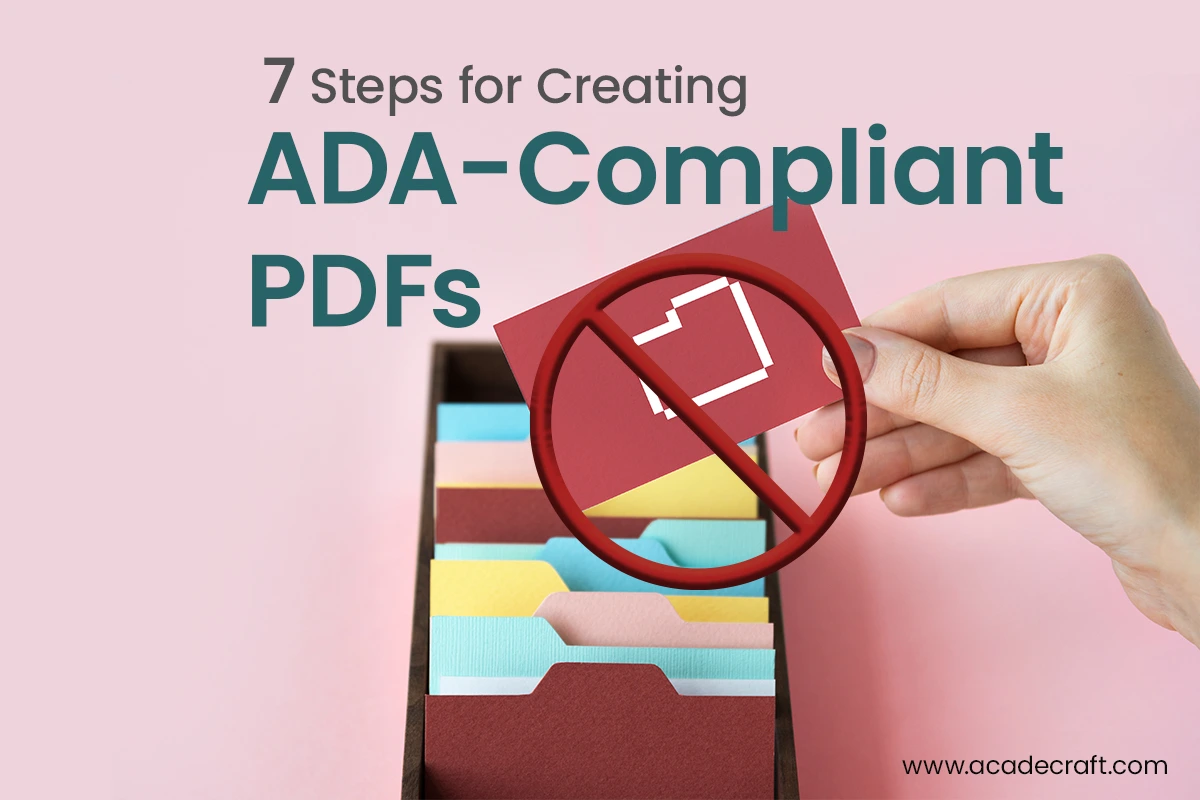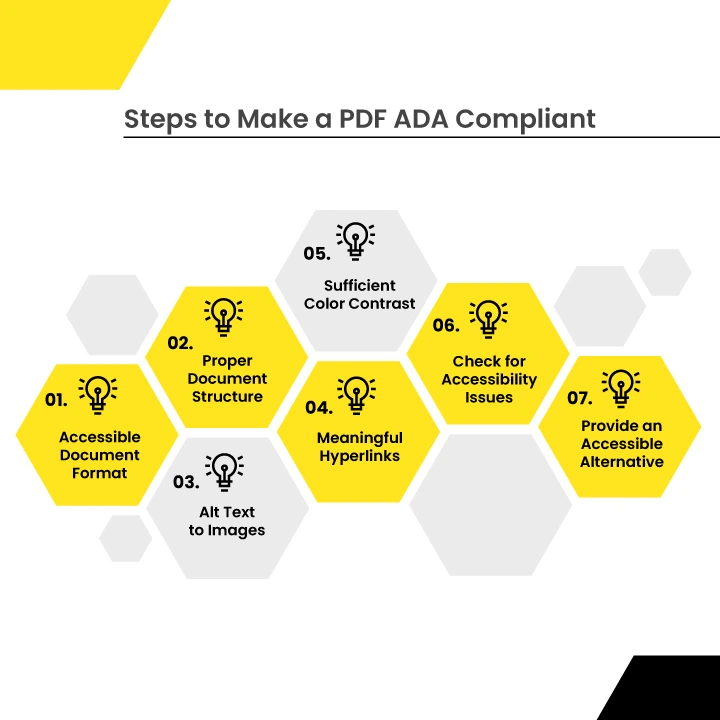
PDFs are a widespread format for sharing documents, and they must be accessible to each user, including individuals with disabilities. Creating an ADA-compliant PDF can seem intimidating, though with the below-mentioned steps, you can ensure that the PDF is accessible to all users.
For instance, when creating a PDF, it is important to ensure that the document contains alternative texts for images and logical heading structure and is tagged with the correct language. The font size should likewise be bigger, enough to be easily readable, and the document should be optimized for screen readers. Additionally, all links should be clearly labeled and clickable.
In this blog, you will understand everything corresponding to ADA and how to create PDFs compiled with it.
ADA, or the Americans with Disabilities Act, is a significant law issued by President George Bush in 1990. It is America's most powerful law concerning civil rights and accessibility for people with disabilities, possessing web accessibility.
ADA compliance helps ensure digital documents, such as PDFs, are accessible to people with disabilities. It includes providing alt text writing for images and videos, adding captions to audio files, and ensuring the document is navigable using a keyboard.
An ADA-compliant PDF is a PDF document that meets the conditions of the Americans with Disabilities Act (ADA) for accessibility. It was made law in 1990 and required businesses and organizations to provide equal access to people with disabilities.
In the context of PDF documents, the document must be designed to make it accessible to users with disabilities. PDF assembled with ADA requirements incorporates those who are visually impaired or have a mobility impairment.
The document must have alt text for images, text-to-speech, and keyboard navigation. It must also have properly tagged headings and structure and be optimized for screen readers. Moreover, the document must be designed to work with adaptive technologies such as magnification software and speech recognition software.
Also Read:What is ADA-Compliance and Why is it Important?
Making ADA-compiled PDFs are important for several reasons.
There are numerous ways and steps that you can take to make your PDF ADA-compliant. Here are some of the most important:

The first step in constructing a PDF with ADA requirements is to use an accessible document format. PDF documents are typically accessible but can become inaccessible if not properly designed. To ensure that the PDF is accessible to all, we have to use a format designed for accessibility, such as PDF/UA (Universal Accessibility).
PDF/UA is a standard for creating accessible PDF documents. It defines a set of guidelines for creating documents that are accessible to users with disabilities. By using PDF/UA, you can ensure that your PDF document meets the requirements of the ADA and is accessible to all users.
The next step in creating a PDF with ADA compliance is to use a concrete document structure. Document structure refers to how the document is organized, including headings, paragraphs, and lists. The proper document structure is important for accessibility because it helps users navigate the document more easily.
To create proper document structure in your PDF, use headings to identify sections of the document and use lists to present information in a structured format. It would help if you also used paragraph styles to ensure that the text is properly formatted and easy to read.
Images are an important part of many PDF documents but can be inaccessible to visually impaired users. You should add alt text to images to ensure all users online can access the information in your PDF.
Alt text is an explanation of the image read aloud by screen readers. It allows visually impaired users to understand the digital image's content. To include an alt text to an image in your PDF, right-click on the image and select "Edit Alt Text".
Hyperlinks are another important feature of PDF documents, while they can be difficult to use for visually impaired users. Use meaningful hyperlinks to ensure all users can benefit from the information in your PDF.
Meaningful hyperlinks describe the content of the link rather than simply saying, "Click here." It makes it easier for users to understand the purpose of the link, especially for those using screen readers. Use descriptive text that accurately reflects the link's content to create meaningful hyperlinks in your PDF.
Color is an important aspect of many PDF documents, but it can be difficult for users who are colorblind or have low vision to distinguish between different colors. To ensure that your PDF is accessible to all users, you should ensure sufficient color contrast.
Color contrast refers to the dissimilarity in brightness between two colors. For instance, black text on a white background has high color contrast, while yellow text on a white background has low color contrast. Use high-contrast colors for text and background elements to ensure your PDF has sufficient color contrast.
Once you have created your ADA-compliant PDF, it is important to check for accessibility issues. Several tools can help you identify accessibility issues in your document, such as the Accessibility Checker in Adobe Acrobat.
The Accessibility Checker in Adobe Acrobat identifies accessibility issues in your document and guides how to fix them. It checks for missing alt text, incorrect document structure, and insufficient color contrast. By using this tool, you can ensure that your PDF is fully ADA-compliant.
Interesting Read:Best ADA-Compliant Fonts for Web Accessibility
At last, if you are unable to make your PDF fully ADA-compliant, it is important to provide an accessible alternative.
For example, if you have a PDF document that incorporates complex charts or graphs, you may be unable to make it fully accessible. In this case, you should provide an accessible alternative, such as an HTML version of the document.
An accessible alternative ensures that all users can access the information in your document, even if the PDF version is not ADA-compliant.
PDFs are common, but ADA-compiled PDFs are something everyone should focus on. Here are 5 pathways through which ADA PDFs could benefit you:
Making a PDF ADA-compliant is important in ensuring your content is accessible to all users, regardless of their abilities. By fully utilizing the steps mentioned above in our PDF accessibility services, we ensure to deliver the optimum quality assistance. Also, you can benefit from creating an ADA-compliant PDF with our most useful digital accessibility services, which fully dedicate to assisting users with disabilities.
Remember to use an accessible document format and proper document structure, add alt text to images, use meaningful hyperlinks, ensure color contrast, check for accessibility issues, and provide an accessible alternative if necessary. By doing so, you can ensure that your PDF is fully accessible and compliant with the requirements of the Americans with Disabilities Act.
Share